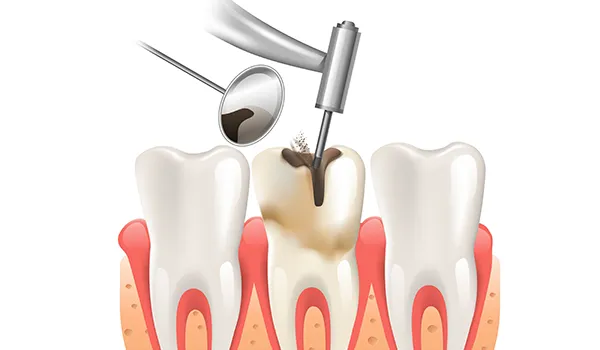Root Canal Vs. Tooth Extraction: Making Informed Oral Health Choices
Dental Implants Solutions
Our mouth's health is essential for our overall well-being, but we often only pay a little attention to it once problems suddenly appear. When we have dental problems, one of the most important choices we have to make is whether to get a root canal, which is a bit complicated or have the tooth taken out for good.
Before we delve into the specifics of these dental procedures, we must grasp the fundamental disparities between them. A root canal and tooth extraction represent two distinct approaches to addressing dental problems, each with unique merits and considerations. Let's explore these options, empowering you to make informed decisions about your oral health.
Understanding Root Canals: A Lifesaver for Compromised Teeth
A root canal, or endodontic therapy in dental terms, is a precise procedure to save a badly damaged or infected tooth. It involves carefully removing the infected or swollen pulp from the tooth's center. Then, the tooth's tiny root canals are meticulously cleaned, disinfected, and sealed. The ultimate goal is to preserve the tooth's natural structure and function.
When Does a Root Canal Come into Play?
A root canal typically emerges as the recommended course of action when a tooth's pulp becomes infected or damaged due to various factors, encompassing deep decay, trauma, or cracks within the tooth. Common symptoms that indicate the necessity of a root canal include enduring excruciating toothache, heightened sensitivity to temperature extremes, gum swelling, and, in severe instances, the potential development of an abscess.
Indicators for Root Canal Therapy
Dentists recommend a root canal when there's a problem deep inside the tooth. This problem can be because of severe decay, an injury, cracks in the tooth, or other reasons. To be a good candidate for a root canal:
- Your tooth should have a damaged or infected part in the center (called pulp) that needs restoration.
- The outside part of the tooth, including the top and roots, should be strong enough to handle the root canal process.
- Root canals work better on teeth that aren't severely damaged. If your tooth is seriously cracked, broken, or too weak, opting for tooth extraction is better.
- You should have generally healthy gums and no untreated gum diseases because gum health is crucial for the root canal to succeed.
- Be ready to take good care of your tooth after the procedure, including keeping your mouth clean, attending follow-up appointments, and being careful with the treated tooth.
- It's important to understand that a root canal can save your tooth and relieve pain, but it doesn't guarantee that your tooth won't have problems. Regular check-ups with your dentist are still essential to monitor how your treated tooth is doing.

Performing a Root Canal: A Step-by-Step Procedure
Executing a root canal involves a series of precise steps:
- The dentist ensures comfort by numbing the affected tooth and the surrounding area.
- Next, the dentist creates a minor access to open the tooth and reach the pulp chamber and root canals. Afterward, the dentist removes the infected or damaged pulp, thoroughly cleans and disinfects the tooth's interior, and finally seals it. Then, a filling or a crown helps restore the tooth's strength and functionality.
The Advantages of Opting for a Root Canal
Choosing a root canal offers several noteworthy advantages:
- Preservation of Natural Tooth:
A root canal's paramount benefit is retaining your natural tooth. This preservation is essential for maintaining proper oral function and a pleasing appearance.
- Pain Relief:
Root canals serve as a remedy for the pain associated with infected or damaged teeth.
- Enhanced Oral Health:
By eradicating the infected pulp and thoroughly disinfecting the tooth, a root canal helps curtail the spread of infection to neighboring teeth, improving oral health.
- Restoration of Function:
A dentist often places a crown on the treated tooth after a root canal. This crown reinforces the tooth and reestablishes its appearance and function.
Understanding Tooth Extraction: A Dental Removal Procedure
Dentists recommend tooth extraction when a tooth has sustained irreparable damage, is causing severe pain, or poses a risk to oral health.
The dentist initiates a pain-free experience throughout the procedure by numbing the tooth's surrounding area. Specialized instruments are then employed to gently loosen the tooth from its socket, followed by a careful extraction. For teeth visible above the gumline, a simple extraction is enough. However, impacted or broken teeth with complex root structures may necessitate surgical extraction, involving more extensive incisions.
Instances Requiring Tooth Extraction
Several circumstances may necessitate tooth extraction:
- Severe Decay:
Teeth severely afflicted by decay or cavities, beyond the scope of effective treatment through fillings or root canals, may demand extraction.
- Impacted Wisdom Teeth:
Wisdom teeth, also recognized as third molars, frequently lack adequate space for proper emergence. Impaction can lead to pain, infection, or harm to adjacent teeth, necessitating their removal.
- Orthodontic Requirements:
Some people might need teeth removed for orthodontic treatment to make enough space to align correctly.
- Infection or Abscess:
If tooth infections or abscesses do not improve with antibiotics or root canal treatment, the dentist may consider tooth removal to prevent harm to other teeth.
Diverse Facets of Tooth Extractions
Tooth extractions fall into two primary categories:
- Simple Extraction: This method involves gently loosening the tooth with forceps and removal. Local anesthesia typically guarantees a pain-free experience.
- Surgical Extraction: Surgical extraction may be necessary when dealing with impacted teeth featuring intricate root structures. This process may involve incisions in the gum tissue and, on occasion, the removal of bone to access and extract the tooth.

Weighing the Pros and Cons of Tooth Extraction
- Pain Relief:
Extracting a severely painful or infected tooth offers swift relief from discomfort.
- Infection Prevention:
Extraction curtails the potential spread of infection to adjacent teeth and surrounding tissues.
- Orthodontic Advantages:
In cases of overcrowding or misalignment, tooth extraction can facilitate orthodontic treatment, leading to a more harmonious smile.
- Loss of Natural Tooth:
The main downside is the permanent loss of a natural tooth, which can affect your chewing capability and your smile.
- Subsequent Replacement:
Extracted teeth may require replacement with dental implants, bridges, or dentures to restore function and appearance.
Root Canal vs. Tooth Extraction: A Comprehensive Comparison
- Preservation vs. Removal:
Root canal therapy revolves around preserving your natural tooth. It resembles a dental rescue operation where the dentist removes the infected or damaged pulp, cleanses the tooth's interior, and securely seals it.
This procedure enables you to retain your original tooth, ensuring its functionality and appearance endure. Conversely, tooth extraction involves completely removing the affected tooth from its socket. It bids farewell to the natural tooth forever.
- Pain and Recovery:
Root canal therapy minimizes pain during the procedure; patients typically find relief from the pain, and it helps maintain their life quality. Recovery is swift, with most patients returning to regular activities within a day or two. Some may experience mild discomfort immediately post-procedure, but it's usually manageable with over-the-counter pain relievers.
In contrast, tooth extraction can induce more discomfort, particularly with impacted or deeply rooted teeth. Recovery may span a bit longer, accompanied by swelling and pain lingering for a few days.
- Long-Term Considerations:
When comparing these two procedures, it's crucial to consider their long-term effects. Root canal therapy is an excellent option as it preserves your natural tooth whenever possible. However, it doesn't guarantee complete protection against future issues. Regular dental examinations are crucial for monitoring the ongoing health of the treated tooth.
In the case of a tooth extraction, you have to compromise your natural tooth. Later, you will require dental implants, bridges, or dentures to restore both function and appearance to your mouth. These replacement options can be more complex and costly than undergoing a root canal.
Concluding Reflections:
Consulting a qualified dentist or an oral surgeon will help you decide between a root canal and tooth extraction. They possess the expertise to evaluate your distinct circumstances, engage in thorough discussions regarding your options, and skillfully navigate you toward the most appropriate path for your oral health. Your smile is an enduring companion, and with the informed choice, it can perpetually brighten your days.
Contact your dentist in Walnut Creek, Dr. Massood Darvishzadeh, at Dental Implant Solutions to learn more about Root Canal and Tooth Extraction.
Resource:
Tips for a Speedy Recovery After a Tooth Extraction
*This media/content or any other on this website does not prescribe, recommend, or prevent any treatment or procedure. Therefore, we highly recommend that you get the advice of a qualified dentist or other medical practitioners regarding your specific dental condition*
Subscribe To Our Newsletter
Get Updates And Learn From The Best
More To Explore



CONTACT US
Massood Darvishzadeh, DDS
2021 Mt Diablo Blvd., Suite 100A
Walnut Creek, CA 94596
(925) 939-2600info@dentalimplantsolutions.net